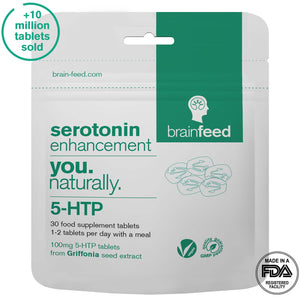January Blues or Blue Monday 2024? 10 evidence-based mood tips
filter
The start of a new year brings a sense of optimism and possibility for many. As the holiday season comes to an end, January represents a fresh slate and a chance to set inspiring goals for personal growth and positive change. While some may feel motivated by the energy of a new beginning, others can experience the January blues. Why are January blues a thing? The cold weather, dark days, and post-holiday letdown can dampen spirits.
What is the saddest day of the year?
The third Monday of January earns the crown with its popular nickname "Blue Monday". Blue Monday 2024 takes place on the 15th of January this year and is a day supposedly when people feel especially glum. What is the evidence you say and is Blue Monday a real thing? Blue Monday’s name was originally coined in 2005 by a travel company's marketing department to sell more holidays. They developed a non-scientific “formula” to calculate a day encompassing low mood and Monday’s blues symptoms, dubbing it the most depressing day of the year. It used a medley of factors like weather, motivation, and financial and goal-setting barriers to propose the Blue Monday myth[1]. Yet, years on, Blue Monday has stuck around and added to the winter depression conversation, despite its lack of any research evidence. Whilst Blue Monday is a myth, many still feel the January blues after the December high. Here are 10 evidence-based tips for beating the January blues!
How do you deal with Blue Monday?
With self-care, social connection, and focusing on the little joys in each day, you can lift your mood. Here are 10 tips on how to do it:
1. Balance your mood with good sleep hygiene
Even if the winter weather has you feeling a bit dull, making some small tweaks to your sleep routine can make a world of difference in brightening your mood. The NHS says that even though everyone needs different amounts of sleep, an adult needs 7 to 9 hours on average[2]. If you’re well-rested, you’re feeling better about yourself and take on life in high spirits. Two literature reviews concluded that poor sleep quality leads to feelings of anxiety and depression, therefore, restful sleep can help you keep your mood high[3,4]. Focusing on winding down at a consistent time each evening by dimming the lights and putting away electronics at least 2 hours before bed helps ease the transition into quality sleep. Getting enough restorative rest in a cool, quiet room sets you up to greet Blue Monday with energy and optimism. So be sure to stick to a regular sleep schedule, avoid caffeine late in the day, and create an inviting sleep sanctuary to beat the blues. Read about the benefits of 5-htp for sleep.
2. Power through Blue Monday with love and support
Even the brightest spirits can feel a little overwhelmed in January. Studies show that hugging a friend or snuggling with your significant other releases the "love hormone" that eases stress and anxiety called oxytocin[5] A movie night with your family or chat over coffee with a coworker can lift your spirits too. Focus on the little things - like a smile from your loved one when you get back home - and spread more of that light to those around you. So, how to cheer someone up on Blue Monday? A simple "how are you" text to check in on someone can make a world of difference.
3. Natural mood regulator - serotonin (5htp)
January brings periods of low natural light which intensifies the low mood symptoms of seasonal affective disorder. Your feel-good brain chemical, serotonin, is responsible for regulating your mood[6,7]. Making more serotonin in your brain can brighten up your mood. Protein-rich foods like beef, tofu, and dairy, contain tryptophan, the building block of serotonin[8]. A small part of this is converted to 5-htp which is then converted to serotonin. How can I improve my mood on Blue Monday? A more efficient way of boosting serotonin is with a 5-htp supplement. High-quality 5-htp supplements can increase your serotonin levels quicker. Try the world’s smallest, nutrient-dense tablet made of 98% 5-htp.
4. Gear up for a motivational Monday
Mid-January is the perfect time to review the resolutions and amp up the motivation to stay on track. Your reward and pleasure brain chemical, dopamine can help. Dopamine also drives the motivation to achieve goals, as seen in energetic hard workers who have higher dopamine levels[9]. Its release prompts you to overcome the fear and challenges of the task at hand to achieve the rewarding feeling[10]. So, how to be positive on Blue Monday? A protein building block called tyrosine is used to produce dopamine in the brain. It is found in dairy, meat, and tofu and as a supplement. Adequate tyrosine is essential for dopamine production. The world’s 1st natural 800mg tyrosine capsule made from fermented corn is one way to safely boost tyrosine levels.
5. Get moving for a brighter Monday
Your body is happy when it's moving. Improving your physical activity levels is one of the best Blue Monday mental health tips. Physical activity improves mood and mental well-being due to increased flow of blood to the brain, regulation of stress response, and activation of areas that control mood and motivation[11]. There are numerous options apart from going to the gym for a dose of good mood. Physical activity of all kinds can help you feel better:
- Walking for 40-60 minutes can improve your mood by almost 20%[12].
- If you prefer the gym approach, 36 minutes on the bike at moderate intensity can lower depressive scores by almost 25%[13]. You can read more about the mental benefits of weight training.
- Swimming can also refresh your mood. Depressive scores decreased by over 60% after pool swimming and almost 50% after an open-water swim[14]. Read about swimming - the ultimate exercise for brain health.
- Dancing for 75 minutes, twice a week can reduce depressive scores by over 25%[15].
6. Blue skies vs Blue Monday
Did you know sunlight and blue skies have a mood-boosting power? Getting outside for even a short while and soaking in those rays can lift your spirits. A study on nurses in China, who lack exposure to natural light at work, found that more sunlight hours per day positively impacted their mental health[16]. The nurses reported better mood and sleep habits. So if you’re a bit clouded by the January blues, go for a sunny stroll or find a nice bright window to sit by. Science says the sunlight will give your mood a boost, making any day - even Blue Monday - a little bit brighter.
7. Healthy eating to brighten up your day
If sun rays are staying behind the clouds in January, focusing on nutritious foods can aid your functioning as well. Wondering what foods could help you feel and do better during Blue Monday? Here’s what the science says. The popular Mediterranean diet was proven to help support brain structure in areas which help speed up the processing of information[17], while the MIND diet and the Nordic diet are great for maximizing memory power[18,19]. Learn more about the best foods for brain health. All of these brain-healthy diets have certain commonalities. If you can, you should eat unprocessed, local and seasonal foods. Be mindful of your high intake of whole grains, legumes, fruits (especially berries) and vegetables, while keeping a low intake of meat, sugar and processed foods. Make sure your fish and seafood intake is moderate and limit alcohol intake as much as possible. With some planning and positivity, healthy foods offer fuel to spark mental clarity on the dreariest of days.
8. Dry January can lift your mood
Even during a rainy January, you can still choose to stay dry. Choosing to stay sober for "Dry January" and maybe even beyond helps clear the mind and improves mood. Alcohol is a well-known contributor to anxiety, low mood and depression[20]. Dry January is a great opportunity to encourage yourself to stay sober and stabilise your mood. The UK-based Dry January campaign that has been supporting people since 2013 stands on the belief that practising sobriety for a month gives people a great deal of confidence to carry on drinking water and juice on nights out even after January has ended[21]. Jump on the sobriety bandwagon and keep your spirits high.
9. Living the life of Blue Zone communities
Another tip is hiding in the world's Blue Zones’ happiness secrets. Those are the places where people live the longest and healthiest lives. People living in the Blue Zones share lifestyle factors like strong family bonds, legumes and plant-heavy “blue zones” diet, constant moderate physical activity and frequent social engagement. Dan Buettner, the Blue Zones founder, wrote about 8 important lessons from Blue Zones for slowing down which are:
- having faith,
- being a part of a community,
- cultivating a garden,
- eating with friends and family,
- happy hour with a glass of wine,
- nap,
- move naturally and frequently, and
- get anywhere from 8 to 10 hours of sleep[22].
Maintaining these healthy habits can boost your mood even on the dreariest of days. Surrounding yourselves with loved ones, staying active outdoors, contributing to your community, and fueling your body with wholesome foods provide a sense of meaning that transcends the cold weather.
10. Practice gratitude to lift your spirits
Focusing on what you're thankful for boosts your mental health. Therefore, making gratitude a daily habit can dramatically improve your emotional intelligence and reduce levels of the stress hormone cortisol[23,24,25]. You can learn more about how do gratitude and mental health tie together. To sum up, take time to reflect on relationships, opportunities, nature, health, or simple pleasures that enrich your emotional world. For example, write a list of 10 things you appreciate or share your gratitude with loved ones. Even on the dreariest days, there are always things to be grateful for if you look around with positivity.
Adopting these 10 simple scientific strategies can turn any gloomy day into a day of joy and well-being.
References
[1] Sheerin, P. (2021). What is Blue Monday and how to overcome it? We Are Wellbeing. https://wearewellbeing.co.uk/insights/what-is-blue-monday-and-how-to-overcome-it/
[2] Insomnia (2021). NHS. https://www.nhs.uk/conditions/insomnia/#:~:text=Everyone%20needs%20different%20amounts%20of,need%209%20to%2013%20hours
[3] Pires, G. N., Bezerra, A. G., Tufik, S., & Andersen, M. L. (2016). Effects of acute sleep deprivation on state anxiety levels: a systematic review and meta-analysis. Sleep Medicine, 24, 109–118.
[4] Alvaro, P. K., Roberts, R. M., & Harris, J. K. (2013). A Systematic Review Assessing Bidirectionality between Sleep Disturbances, Anxiety, and Depression. Sleep, 36(7), 1059–1068.
[5] Uvnas-Moberg K, Petersson M. (2005). Oxytocin, a mediator of anti-stress, well-being, social interaction, growth and healing. Zeitschrift fur Psychosomatische Medizin und Psychotherapie, 51(1), 57-80.
[6] Hariri, A. R., & Brown, S. M. (2006). Serotonin. American Journal of Psychiatry, 163(1), 12–12.
[7] Serotonin (2022). Cleveland Clinic. https://my.clevelandclinic.org/health/articles/22572-serotonin#:~:text=Mood%3A%20Serotonin%20in%20your%20brain,serotonin%20are%20associated%20with%20depression.
[8] Foods Highest in Tryptophan (n.d.). My Food Data. https://tools.myfooddata.com/nutrient-ranking-tool/tryptophan/all/highest/grams/common/no
[9] Treadway, M.T. et al. (2012). Dopaminergic Mechanisms of Individual Differences in Human Effort-Based Decision-Making. The Journal of Neuroscience,32(18), 6170–6176.
[10] Salinas-Hernández, X.I. et al. (2018). Dopamine neurons drive fear extinction learning by signaling the omission of expected aversive outcomes. eLife, 7.
[11] Sharma, A. et al. (2006). Exercise for mental health. Primary care companion to the Journal of clinical psychiatry, 8(2), 106.
[12] Brand, S. et al. (2018). Acute Bouts of Exercising Improved Mood, Rumination and Social Interaction in Inpatients With Mental Disorders. Frontiers in psychology, 9, 249.
[13] Ligeza, T. S. et al. (2023). The effects of a single aerobic exercise session on mood and neural emotional reactivity in depressed and healthy young adults: A late positive potential study. Psychophysiology, 60(1), e14137.
[14] Massey, H. et al. (2020). Mood and well‐being of novice open water swimmers and controls during an introductory outdoor swimming programme: A feasibility study. Lifestyle Medicine, 1(2).
[15] Hyvönen, K. et al. (2020). The Effects of Dance Movement Therapy in the Treatment of Depression: A Multicenter, Randomized Controlled Trial in Finland. Frontiers in psychology, 11, 1687.
[16] Wang, J., Wei, Z., Yao, N., Li, C., & Sun, L. (2023). Association Between Sunlight Exposure and Mental Health: Evidence from a Special Population Without Sunlight in Work. Risk Management and Healthcare Policy, 16, 1049–1057.
[17] Jaqua, E. et al. (2023). The Impact of the Six Pillars of Lifestyle Medicine on Brain Health. Cureus, 15(2), e34605.
[18] Medina dos Santos, N. et al. (2019). Current evidence on cognitive improvement and neuroprotection promoted by anthocyanins. Current Opinion in Food Science, 26, 71–78.
[19] Männikkö, R. et al. (2015). The Nordic diet and cognition--The DR's EXTRA Study. The British journal of nutrition, 114(2), 231–239
[20] Understanding alcohol use disorders and their treatment (2018). American Psychological Association. https://www.apa.org/topics/substance-use-abuse-addiction/alcohol-disorders
[21] Ballard, J. (2016). What is Dry January? The British Journal of General Practice: The Journal of the Royal College of General Practitioners, 66(642), 32.
[22] Buettner, D. (n.d.). 8 Blue Zones Lessons For Slowing Down. Blue Zones. https://www.bluezones.com/2013/09/9-blue-zones-lessons-for-slowing-down/
[23] Pang, Y., Song, C., & Ma, C. (2022). Effect of Different Types of Empathy on Prosocial Behavior: Gratitude as Mediator. Frontiers in psychology, 13, 768827.
[24] Karns, C. M., Moore, W. E., & Mayr, U. (2017). The Cultivation of Pure Altruism via Gratitude: A Functional MRI Study of Change with Gratitude Practice. Frontiers in Human Neuroscience, 11, 599.
[25] McCraty, R., & Childre, D. (2004). The Grateful Heart: The Psychology of Appreciation. In R.A. Emmons & M. E. McCullough (Eds.), The Psychology of Gratitude (pp.300 – 254). Oxford University Press.


 alertness
alertness
 cognition
cognition
 sleep
sleep
 wellbeing
wellbeing








Leave a comment
Open tab